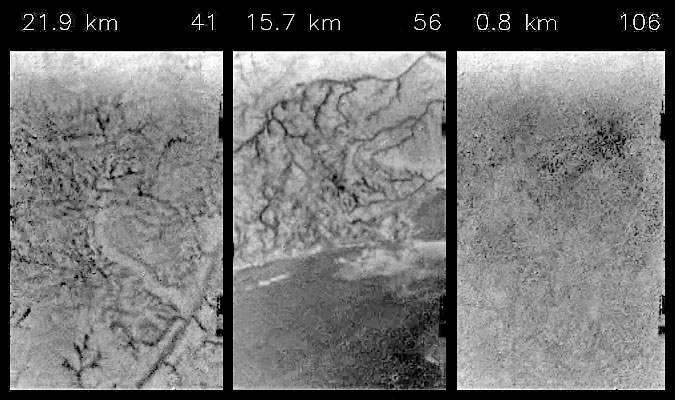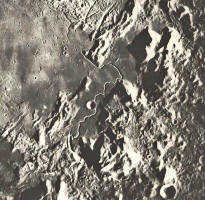|
Jan 21, 2005
Images: ESA/NASA/JPL/University of Arizona
These frames are taken from a short animation made up from a sequence of images taken by the Descent Imager/Spectral Radiometer (DISR) instrument on board ESA's Huygens probe, during its successful descent to Titan on Jan. 14, 2005 (watch below video).
Huygens emerged from the clouds at around 30 kilometers
(about 19 miles) altitude.
For this animation, most images used were captured by the HRI and MRI.
Decent into Titan's Atmosphere (Actual NASA video)
The still frames shown here have been brightened and sharpened a
little to help pick out linear features over a wide range of
altitudes.
More importantly, he explained that,
Lorenz also thought that liquids on
Titan would form crater lakes. Of course, we now know that
Titan
does not sport the craters expected by conventional theory.
The differences from conventional theory could not be starker. Titan was expected to be a youthful moon bearing the electrical scars of its birth and other encounters as it established a stable orbit. The type of scarring was expected to be similar to that of Venus where a heavy atmosphere causes filamentation of cosmic discharges and the formation of surface patterns of sinuous channels. On close inspection some channels would be found to be composed of crater chains.
The images above support the Electric universe model. At different altitudes, the most obvious features are filamentary. There are no large craters. The dendritic pattern in the left hand image shows features that distinguish it as a surface lightning channel, known technically as a “Lichtenberg figure.” Unlike a liquid, surface lightning doesn’t respect the topography and will flow uphill as well as down. There is circumstantial evidence that some of the dark channels seen in early images have their source and sink at the “shoreline” with the darker areas. Hopefully, further analysis will clarify this point.
A surface lightning stroke is accompanied by a corona discharge across the surface at right angles to the main channel. The corona tends to cause “tributaries” of the main discharge to join the main channel at right angles.
It is unusual for rivers to do that, and if
they do it causes erosion of the opposite riverbank. There is no
evidence of channel disturbance at such junctions in the left-hand
image. The corona can also cause transverse features in the channel
floor. On Mars they look like sand dunes in serried ranks along
channel floors. There are hints of this effect in the center and
right-hand images.
The renowned Hadley’s Rille on the Moon (click image left), visited by astronauts, shows this
characteristic. It may require a Titan orbiter, though, before this
kind of detail is available.
|


